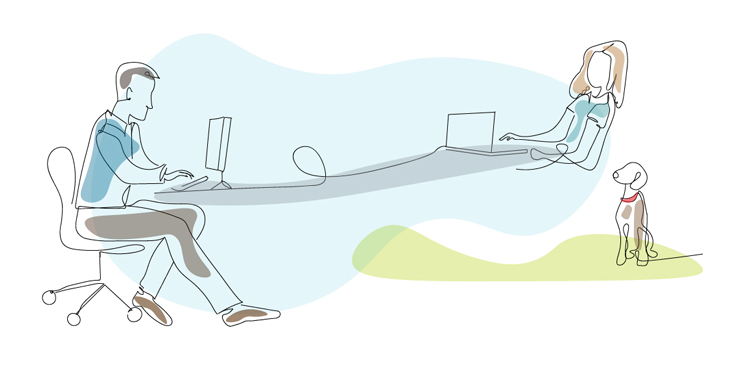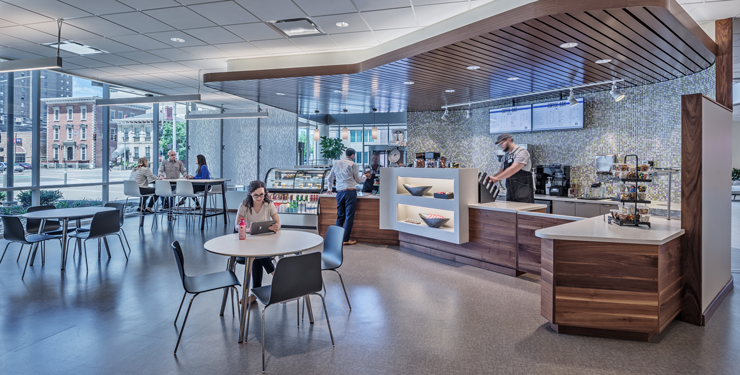
Culture as a Driver of Equity of Experience in Hybrid Work

The exponential increase of remote work, along with the rise of people safely returning to the workplace, provides an outlook for a future of work that is hybrid. In such a world where people are working together toward common goals in different places and at different times, equity of experience is the next frontier. Over the past two years of the pandemic, the opportunity and potential to reimagine the full experience of work—not just the physical workplace—has been inspiring.
Equity of experience needs to move beyond celebrating that everyone’s Zoom, Microsoft Teams, or Google Hangouts box is the same size; it is not time to unfurl the “Mission Complete” banner just yet. In a successful, hybrid ecosystem of work, the experience will be equitable between those working remotely and those in the workplace. To date, the conversation has been dominated by a focus on return to office and the redesign of the workplace. Much is left to consider such as hybrid pre- and post-meeting spontaneous conversations, equitable furniture, equipment, and resources for remote working, and the design of social hubs, meeting rooms, and amenity spaces that take into account the experience for remote employees.
Organizational Culture
While space, tech, and policy are important elements to hybrid work, culture is key to driving equity of experience. As facets of culture, individual behaviors, team norms, and shared expectations will ultimately drive hybrid organizational success or limit it. Change is possible as the pandemic is breaking down traditional, siloed thinking in the design of workplaces to include stakeholders beyond space (CRE) such as tech (IT) and policy (HR). Though, even the most responsive of workplace designs will fail without ensuring culture is supported and reflected in the work experience no matter where and when that takes place.
Individual Behaviors
Behaviors are such a major facet of culture that the two terms are many times used interchangeably. Patterns of behavior are how people act or respond instinctively based on their personal experiences. These ingrained behaviors are the ways an individual takes in information, processes it, acts upon it, learns, and communicates, which are all critical elements of work. New ways of working will need better support for teams to create an equitable experience of working together—whenever and wherever—by developing and sustaining new and adjusted behaviors.
Any change in behavior is difficult; the long-held saying is that it takes 30 days to break a habit. It’s so difficult that most organizations focus on changing the physical workplace because it is easier than having difficult conversations with people about changing work behaviors. With such a seismic shift in the way people work, if an organization hasn’t done so, now is the time to have those difficult conversations. All levels of an organization will need training on new ways of work to ensure equity of work experience from leadership to managers to “rank and file.” With many organizations moving from decades of 100% in-office work, to the last two years being 100% remote, to recently or soon moving to a hybrid way of working, new behaviors will arise, and it is better to be proactive in guiding the development of those behaviors across new ways of working, managing, and interacting.
Team Norms
Team norms are the shared rules, implicit and explicit, that guide the behaviors of a team. In hybrid work, teams will need to develop new norms of working and engaging with each other as well as those outside of their team. An example of a team norm is not working through lunch. Instead, people take a lunch break or some time for respite away from work to recharge because the team believes that such behavior is important to both a person’s wellbeing and effectiveness.
As opposed to most work being done in the workplace at the same time, new team norms will be a mixture of sometimes together (synchronous) and sometimes apart (asynchronous) with much of the work happening at home or remotely for many people. The rhythms of work will need to adjust from historically planning one day at a time to planning out at least seven days (a week) at a time. It’s not just about when but where the work is going to happen for each person on the team. This is not to be confused with individual preference; the needs of the team must take priority over the preferences of the individual. While this speaks to just a single team within an organization, it only gets more complex with the intersection of additional internal and external teams.
Shared Expectations
While norms can be viewed as rules, they also define expectations of behaviors. These relate to an individual or group’s beliefs of how things will work and are many times based on norms. When there is misalignment between what is expected and reality, it negatively impacts people’s perception of that experience. If such misalignment continues, it can lead to toxic work experiences for people which can negatively impact emotional, mental, and physical wellbeing, productivity, effectiveness, and retention.
With such a significant shift in how people are working, expectations will shift as well. As people return to the workplace, they will expect changes to health and safety protocols as well as to physical spaces to support new ways of working. The most frequent concerns raised by clients and their people have been about uncontrolled “acoustics,” or the anxiety of returning to the physical office to sit on virtual video calls amongst a sea of others on video calls, and how to engage with those working in other places and times different from themselves. With work truly becoming hybrid, the questions of why, how, where, and when of engagement between people will be more important than ever. And with that comes all new expectations from navigating a diversity of relationships across different mediums of audio calls, video calls, chat, email, and in-person interaction in an equitable manner.
Plan For the Journey, Not the Destination
While there has been great disruption and reactionary change already, there is much more to manage and lead ahead. Still, in a period of transition, any workplace redesign for return to office should be viewed as a temporary solution. While people will expect changes to the workplace while they have been away working remote, once they return, it is going to take six to twelve months for people to create new and/or adjust behaviors, team norms, and expectations. This period of change will impact those working remotely as well as interactions with in-office colleagues. Individual, team, and organizational attitudes regarding preference and feasibility for in-office, remote, or hybrid work will change over this transitional period—underscoring the importance of connections between people and establishing feedback loops where possible.
Going forward, some level of hybrid work and engagement will be a reality for all organizations. Even if an organization’s people are primarily working on-site, the reality is that they will be working with clients, partners, and others that are not working in the same way. The future of work must be flexible to support people and different forms of working, both in the experience of work for all in addition to the physical workplace. Right now is the time for organizations to test and learn with their people to co-create an equitable experience for their shared future of work.
Author
Content Type
Date
May 02, 2022
Market
Topic
Workplace Strategy
Hybrid Work
Distributed Work



